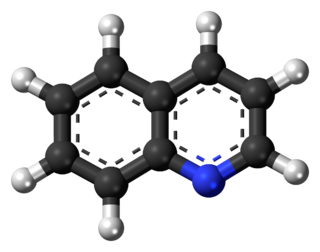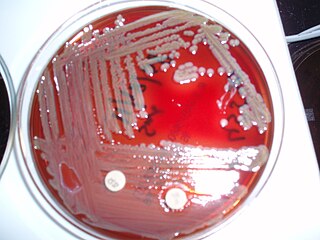
Quinoline is a heterocyclic aromatic organic compound with the chemical formula C9H7N. It is a colorless hygroscopic liquid with a strong odor. Aged samples, especially if exposed to light, become yellow and later brown. Quinoline is only slightly soluble in cold water but dissolves readily in hot water and most organic solvents. Quinoline itself has few applications, but many of its derivatives are useful in diverse applications. A prominent example is quinine, an alkaloid found in plants. Over 200 biologically active quinoline and quinazoline alkaloids are identified. 4-Hydroxy-2-alkylquinolines (HAQs) are involved in antibiotic resistance.

Indole-3-acetic acid is the most common naturally occurring plant hormone of the auxin class. It is the best known of the auxins, and has been the subject of extensive studies by plant physiologists. IAA is a derivative of indole, containing a carboxymethyl substituent. It is a colorless solid that is soluble in polar organic solvents.

Elizabethkingia meningoseptica is a Gram-negative, rod-shaped bacterium widely distributed in nature. It may be normally present in fish and frogs; it may be isolated from chronic infectious states, as in the sputum of cystic fibrosis patients. In 1959, American bacteriologist Elizabeth O. King was studying unclassified bacteria associated with pediatric meningitis at the Centers for Disease Control and Prevention in Atlanta, when she isolated an organism that she named Flavobacterium meningosepticum. In 1994, it was reclassified in the genus Chryseobacterium and renamed Chryseobacterium meningosepticum(chryseos = "golden" in Greek, so Chryseobacterium means a golden/yellow rod similar to Flavobacterium). In 2005, a 16S rRNA phylogenetic tree of Chryseobacteria showed that C. meningosepticum along with C. miricola were close to each other but outside the tree of the rest of the Chryseobacteria and were then placed in a new genus Elizabethkingia named after the original discoverer of F. meningosepticum.
Lysinibacillus sphaericus is a Gram-positive, mesophilic, rod-shaped bacterium commonly found on soil. It can form resistant endospores that are tolerant to high temperatures, chemicals and ultraviolet light and can remain viable for long periods of time. It is of particular interest to the World Health Organization due to the larvicide effect of some strains against two mosquito genera, more effective than Bacillus thuringiensis, frequently used as a biological pest control. L. sphaericus cells in a vegetative state are also effective against Aedes aegypti larvae, an important vector of yellow fever and dengue viruses.

Indole is an aromatic heterocyclic organic compound with formula C8H7N. It has a bicyclic structure, consisting of a six-membered benzene ring fused to a five-membered pyrrole ring. Indole is widely distributed in the natural environment and can be produced by a variety of bacteria. As an intercellular signal molecule, indole regulates various aspects of bacterial physiology, including spore formation, plasmid stability, resistance to drugs, biofilm formation, and virulence. The amino acid tryptophan is an indole derivative and the precursor of the neurotransmitter serotonin.

Rhizoctonia is a genus of anamorphic fungi in the order Cantharellales. Species do not produce spores, but are composed of hyphae and sclerotia and are asexual states of fungi in the genus Thanatephorus. Rhizoctonia species are saprotrophic, but are also facultative plant pathogens, causing commercially important crop diseases. They are also endomycorrhizal associates of orchids. The genus name was formerly used to accommodate many superficially similar, but unrelated fungi.

Tryptophol is an aromatic alcohol that induces sleep in humans. It is found in wine as a secondary product of ethanol fermentation. It was first described by Felix Ehrlich in 1912. It is also produced by the trypanosomal parasite in sleeping sickness.

Clostridium sporogenes is a species of Gram-positive bacteria that belongs to the genus Clostridium. Like other strains of Clostridium, it is an anaerobic, rod-shaped bacterium that produces oval, subterminal endospores and is commonly found in soil. Unlike Clostridium botulinum, it does not produce the botulinum neurotoxins. In colonized animals, it has a mutualistic rather than pathogenic interaction with the host.
Acidobacterium capsulatum is a bacterium. It is an acidophilic chemoorganotrophic bacterium containing menaquinone. It is gram-negative, facultative anaerobic, mesophilic, non-spore-forming, capsulated, saccharolytic and rod-shaped. It is also motile by peritrichous flagella. Its type strain is JCM 7670.

Affinisine is a monoterpenoid indole alkaloid which can be isolated from plants of the genus Tabernaemontana. Structurally, it can be considered a member of the sarpagine alkaloid family and may be synthesized from tryptophan via a Pictet-Spengler reaction.
Lysinibacillus fusiformis is a gram-positive, rod-shaped bacterium of the genus Lysinibacillus. Scientists have yet to completely characterize this microbe's pathogenic nature. Though little is known about this organism, several genome sequencing projects for various strains of L. fusiformis are currently underway.

Nosiheptide is a thiopeptide antibiotic produced by the bacterium Streptomyces actuosus.
Streptomyces atrovirens is a bacterium species from the genus Streptomyces which was isolated from soil in Egypt. Streptomyces atrovirens produces indole-3-acetic acid.
Dyadobacter endophyticus is an endophytic, aerobic and rod-shaped bacterium from the genus of Dyadobacter which has been isolated from a maize root from Beijing in China.
Mariniluteicoccus endophyticus is a Gram-positive, aerobic and non-motil bacterium from the genus of Mariniluteicoccus which has been isolated from the root of the plant Ocimum basilicum from Shilin County in China.
Arthrobacter endophyticus is a Gram-positive, aerobic and non-motile bacterium from the genus of Arthrobacter which has been isolated from the roots of the plant Salsola affinis in Urumqi in China.
Gluconacetobacter diazotrophicus is a bacterium with a rod-like shape, has circular ends, and can be classified as a Gram-negative bacterium. The bacterium is known for stimulating plant growth and being tolerant to acetic acid. With one to three lateral flagella, and known to be found on sugarcane, Gluconacetobacter diazotrophicus was discovered in Brazil by Vladimir A. Cavalcante and Johanna Dobereiner.
Lysinibacillus cresolivorans is a Gram-positive, facultatively anaerobic, rod-shaped and endospore-forming bacterium from the genus of Lysinibacillus.
Lysinibacillus tabacifolii is a Gram-positive, strictly aerobic and endospore-forming bacterium from the genus of Lysinibacillus which has been isolated from leaves of the plant Nicotiana tabacum.
Lysinibacillus yapensis is a Gram-positive, aerobic, spore-forming and motile bacterium from the genus of Lysinibacillus which has been isolated from deep-sea sediments from the Yap Trench.








